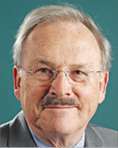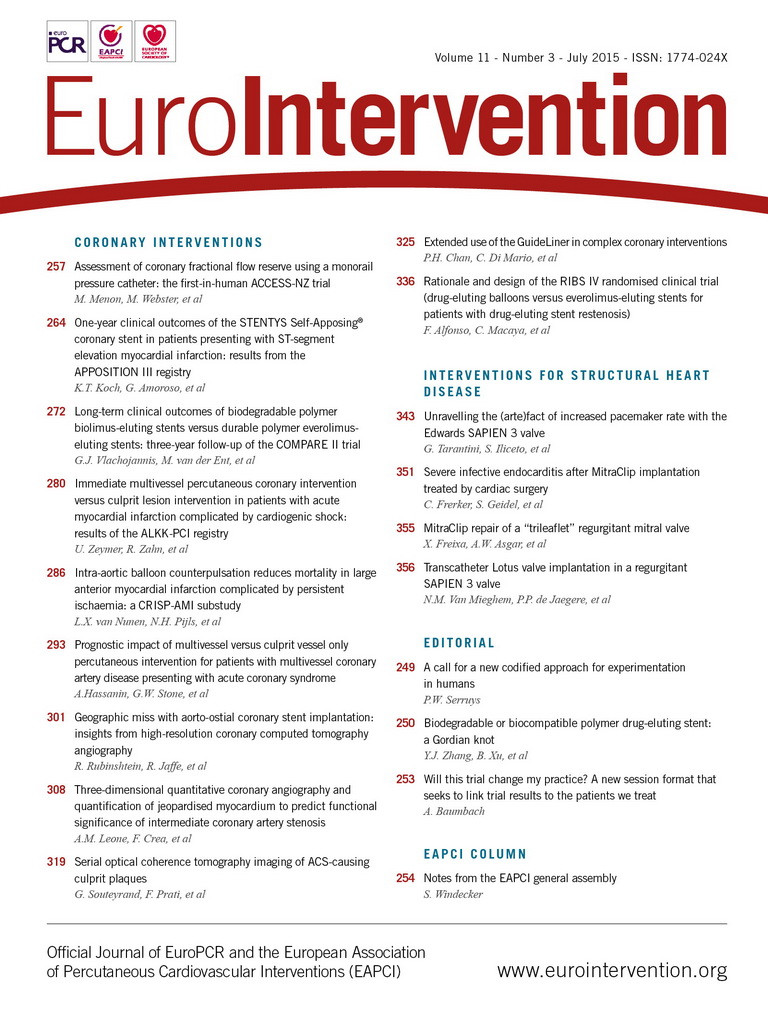
In last month’s editorial, I reflected on the transcatheter percutaneous mitral valve replacement (TMVR) session which took place during this year’s EuroPCR and I dared to map out the course which TMVR will take. At the time of writing the current editorial, I have just returned from the TVT in Chicago and, after some very interesting discussions there, it seemed to me appropriate to follow up on last month’s reflections.
At the beginning and at the end of one of the TVT main arena sessions, Marty Leon rather intriguingly introduced me as his mentor and philosopher. This session was cleverly designed, moving progressively from European registries to “off-label” use of devices to proposed randomised trials conducted in the United States. At a certain point, Marty asked me to discuss the general content of the session. I could not resist turning to the history of interventional cardiology. I mentioned to the audience my editorial of last month in which I spoke about the famous surgeon and pioneer Åke Senning who decided –against the advice of his colleagues– to support Andreas Grüentzig by referring one of Andreas’ first patients to him.
We know the story of the development of a new procedure, a story which still holds true as an example for the future. During the TVT panel discussion, Alain Cribier’s first TAVI patient, who had significant comorbidities exacerbated with cardiogenic shock (LVEF 8%) was prominent in all our minds. Alain’s procedure was spectacular, ingenious and lifesaving: the patient survived to 45 days before succumbing to secondary comorbidities. We all know the obstacles which we have to overcome, such as the extremely elevated EuroSCORE/STS score, and we aspire to a set of high standards that are not necessarily set by surgeons, regulatory bodies or cardiologists, but by the community in general.
In Europe, the first step for a high-risk therapy is to follow the compassionate use pathway. In other words, whilst you do not to need to seek permission from the local ethics committee, it is mandatory to inform them since, as an operator, you will need to take full responsibility for the treatment that you as a physician estimate to be the only life-extending possibility available. Unfortunately, but not unexpectedly, most patients die shortly after such a procedure takes place. Within this field we have multiple heroes, such as Christiaan Barnard’s first patient who survived the operation and lived for 18 days, finally succumbing to pneumonia due to the immunosuppressive medication.
In Europe, after these first few compassionate use treatments, we are allowed to perform the so-called “first-in-man” procedure. The primary goal of this procedure is the safety of patients while using a particular new technique or treatment. The patients are not normally expected to derive any therapeutic benefit, nor is this the vehicle to prove efficacy. Once safety has been demonstrated, normally a CE mark is granted. Obviously, as long as the device is not CE marked, the sponsor will have to provide the device free of charge. However, after the CE mark is granted, it is up to the operator –the investigator– to provide the funding for the collection of data for evidence-based medicine, something which will later be used for guidelines and, ultimately, reimbursement. In the final phase of development, a randomised trial will be performed. For example, within Europe, we have had three randomised trials in the TAVI arena (STACCATO, CHOICE and NOTION).Across the pond, the USA frequently benefits from the adventurous and risky endeavour of European cardiologists before designing, in a very careful, but highly bureaucratic manner, their investigational device exemption (IDE) study. This is basically a trial where the new treatment is reimbursed by the state as an equivalent treatment, which is why it is appealing to participate in an IDE treatment for commercial approval. Of course, the process is lengthy, cumbersome and has many hurdles. At the end of the day, if there are solid results supported by sound statistics as well as confirmed results, this might also justify inclusion in the guidelines for their own society.
And now to the heart of the matter. Let us consider the first pilot of the Airbus A380. He had never flown the plane, yet he knew exactly what to do: how to raise this colossus of 573 tonnes from the ground, how to keep it in the air, how to fly the perfect trajectories without taking any risks. Now let us try to transpose this mechanical engineering example into our field. Today, with the advent of 3D printing, simulation-based preoperative planning programmes, the length of preparation of animal or even human heart, taking advantage of angioscopy in the left atrium, the left ventricle... with all these aids it is possible to test and to visualise exactly how the device is going to behave and react in the valve, how it will adjust to the contours, how it will become haemodynamically anchored in the surrounding environments, and how it will respect the behaviour of the chordae and the papillary muscles.
Marty Leon and I were pondering the question as to whether it is not time to plant the seed for a new code of “experimentation in humans” based on a much more rigorous and coded approach to “first in man”, using a host of evidence collected in situations that do not endanger the patient. Marty responded very positively to this idea, and this is the first, albeit very rudimentary, early step. Certainly, in the forthcoming years, Marty and I will come back with something more solid. For now, one must remember that ideas start simply with the planting of a simple seed.

